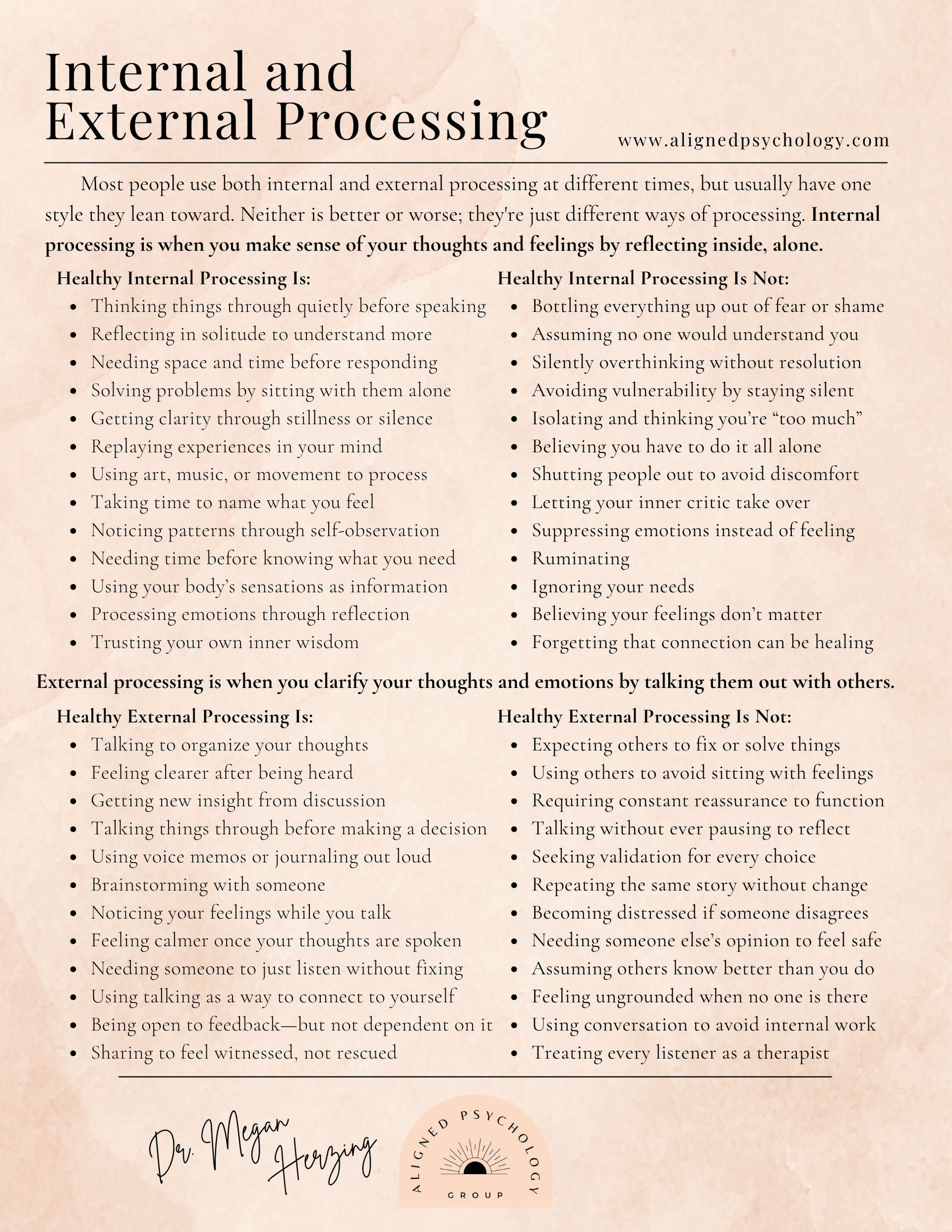Trauma Therapy Homework - Week 25
Week 25: (The Basics) Relationship Mini Series
Internal and External Processing
Welcome to Week 25 of your trauma therapy journey. This week, we’re diving into something that affects how we understand ourselves and relate to others—how we process our thoughts and emotions. You’ve probably heard someone say, “I just need to talk this out,” or maybe you’re the type who needs to journal, reflect, and sit with things quietly before sharing. These are two very different but equally valid ways of processing: internal and external. Understanding your own processing style (and the styles of people around you) is a powerful step toward better communication, emotional regulation, and relationship harmony. Let’s get into it.

What Is Internal Processing?
Internal processors are people who need time and space to think things through before they speak or take action. If you’re an internal processor, you might find yourself needing to go on a walk, sit in silence, or write in a journal when something big happens. You might replay conversations in your head, sort through your emotions privately, and only open up to others once you feel clear about what’s going on inside you.
This type of processing often feels slow to others, but it’s deeply thoughtful. Internal processors tend to be self-reflective and insightful. They usually feel overwhelmed or pressured when asked to “talk it out” before they’re ready. It’s not that they’re avoiding or shutting down—they’re just doing the work internally first.
Healthy Internal Processing Is:
- Thinking things through quietly before speaking
- Journaling to organize emotions or ideas
- Reflecting in solitude to understand your reactions
- Needing space and time before responding
- Making sense of feelings by observing them privately
- Having rich internal conversations or mental rehearsals
- Solving problems by sitting with them alone
- Getting clarity through stillness or silence
- Replaying experiences in your mind to understand them
- Using art, music, or movement to process emotions
- Taking time to name what you feel
- Noticing patterns through self-observation
- Feeling more comfortable sorting through things alone
- Needing time before knowing what you want or need
- Using your body’s sensations as information
- Reaching insight through mindfulness or meditation
- Feeling less reactive with space to think
- Processing emotions through reflection
- Trusting your own inner wisdom to guide decisions
- Creating internal rituals or practices for reflection
Healthy Internal Processing Is Not:
- Bottling everything up out of fear or shame
- Assuming no one would understand you
- Silently overthinking without resolution
- Avoiding vulnerability by staying silent
- Isolating because you think you’re “too much”
- Believing you have to do it all alone
- Shutting people out to avoid discomfort
- Letting your inner critic take over unchecked
- Suppressing emotions instead of feeling them
- Believing reflection is the same as ruminating
- Ignoring your needs because you don’t want to ask for help
- Believing your thoughts or feelings don’t matter
- Never voicing your experiences even when it would help
- Fearing being misunderstood so much that you never try
- Getting stuck in loops of self-blame or shame
- Rejecting others’ input even when it’s helpful
- Believing internal means better or more “mature”
- Not realizing you’re allowed to process out loud too
- Withholding until you explode
- Forgetting that connection can be healing too
What Is External Processing?
External processors, on the other hand, figure things out by talking through them. They may call a friend, talk to their partner, or even verbalize thoughts out loud to themselves. External processors often say things like, “I didn’t even know how I felt until I said it out loud.” They process in real-time and tend to feel more grounded when they can bounce ideas off someone else. Silence can feel isolating or anxiety-inducing for them. They often need immediate feedback, reassurance, or just someone to listen as they work through emotions or decisions.
It’s important to note that external processors aren’t necessarily looking for solutions—they may just need to verbalize to organize their thoughts. This can be incredibly effective for clarity and emotional relief.

Disclaimer on What External Processing Is and Is Not
There’s a big difference between using someone as a sounding board and relying on them to tell you what to think or do.
When you use someone as a sounding board, you’re inviting them to listen while you sort through your own thoughts, feelings, or decisions. You’re still connected to your own inner voice—you’re just processing out loud. But when we fall into codependent patterns, we might hand over our power and ask someone else to think or decide for us. This can happen when we don’t trust ourselves or feel overwhelmed by uncertainty. It’s totally human to want guidance or reassurance, especially when things feel hard. But part of healing is learning to hear your own voice and use others to support—not replace—your inner knowing.
Healthy External Processing Is:
- Talking to organize your thoughts
- Saying things out loud to figure out what you feel
- Exploring different ideas in conversation
- Asking questions to clarify what’s going on inside
- Feeling more clear after being heard
- Getting new insight from reflection during a discussion
- Talking things through before making a decision
- Using voice memos, journaling out loud, or voice-to-text
- Brainstorming with someone without needing answers
- Repeating yourself to find what feels true
- Noticing your feelings while you talk
- Finding emotional release through verbal expression
- Bouncing ideas off trusted people
- Feeling calmer once your thoughts are out of your head
- Needing someone to just listen without fixing
- Using talking as a way to connect to yourself
- Venting with the goal of insight, not blame
- Being open to feedback—but not dependent on it
- Sharing to feel witnessed, not rescued
- Allowing your thoughts to take shape through dialogue
Healthy External Processing Is Not:
- Expecting others to fix or solve everything
- Talking over your intuition
- Using others to avoid sitting with feelings
- Requiring constant reassurance to function
- Needing others to agree in order to feel okay
- Relying on someone to think or make decisions for you
- Talking without ever pausing to reflect
- Seeking validation for every choice
- Avoiding silence out of discomfort
- Repeating the same story without openness to growth
- Becoming distressed if someone disagrees
- Needing someone else’s opinion to feel safe
- Assuming others know better than you do
- Talking at someone without attuning to the connection
- Feeling ungrounded unless someone is available
- Blaming others for not giving the "right" answer
- Using conversation to avoid internal work
- Ignoring your own cues in favor of someone else's views
- Treating every listener as a therapist
- Losing your sense of self in other people’s perspectives
Navigating Differences in Relationships
One potential source of tension in relationships is a mismatch in processing styles. Maybe one partner wants to talk things out right away while the other needs space to think. This difference can easily lead to misunderstandings. The external processor might feel abandoned or rejected, while the internal processor might feel pressured or overwhelmed. Here’s the key: both styles are valid. It’s all about honoring the way each person operates. Try setting agreements in advance, like “Can we revisit this conversation in a few hours after I’ve had time to think?” or “I’m not asking you to fix this—I just need to say it out loud.” That mutual understanding creates space for both people to feel respected. An external processor might find it helpful to first ask the internal processor if or when they have the mental and emotional space to listen and support a verbal processing moment. Likewise, the internal processor can support the relationship by letting the external processor know how much time they need before they're ready to revisit the conversation after having time to reflect.

Trauma Work Does Involve Some Internal Processing
Part of healing from trauma is learning how to tune into your inner world. Even if you’re someone who naturally processes things externally, trauma work asks us to slow down and listen to what’s happening inside. That’s because trauma can make us disconnect from our emotions, our body, or our needs—it’s something we often do to stay safe. But healing means gently rebuilding that connection. It means noticing how you feel, what your body is telling you, and what you might need in the moment. It allows us to recognize triggers, track nervous system shifts, and make space for emotions instead of bypassing or projecting them. You don’t have to become a totally different person, but learning how to process things internally—even just a little—can help you feel more grounded, more present, and more in control of your healing.
Final Thoughts
Understanding your processing style is a major act of self-awareness—and a gift to your relationships. Whether you tend to go inward or outward, your method of working through emotions is part of what makes you unique. There's no right or wrong way—just different nervous systems trying to make sense of the world. When we begin to recognize and respect both our own style and others’, we reduce conflict and increase connection. We create more compassionate conversations and safer emotional environments. So this week, notice how you process. Ask yourself what you need, and communicate that clearly. Notice how others process too—and practice responding with curiosity rather than judgment. Remember, healing isn’t about becoming someone you’re not. It’s about learning how you work, and then working with it—gently, patiently, and with care.
FREE Downloadable Handouts
Click this
LINK
for free access to downloadable PDFs from the Trauma Therapy Homework Series. You’ll be directed to my Google Drive folder, where you can explore all the handouts created so far. You can choose between a digital format for easy viewing on your device or a printable version if you prefer a hard copy.


ABOUT THE AUTHOR
Dr. Megan
Megan Herzing PsyD, Licensed Professional Clinical Counselor, specializes in trauma therapy and creating a safe, supportive space for healing. She integrates evidence-based modalities, including EMDR, Internal Family Systems (IFS), somatic therapy, and Emotionally Focused Therapy (EFT), to address the mind-body connection and empower clients on their journey to wellness. With extensive experience treating complex PTSD, anxiety, attachment injuries, and dissociation, she believes in the power of self-compassion and authentic connection to facilitate lasting change. Drawing from her own healing journey, she brings empathy and lived experience to her work, honoring each client’s unique path toward growth and resilience.
Thank you for being part of a community of humans that deeply cares about healing.
We are honored that you stopped by and hope our resources will continue to bring value to your life.
We are accepting new clients in California, and referrals are always appreciated.












